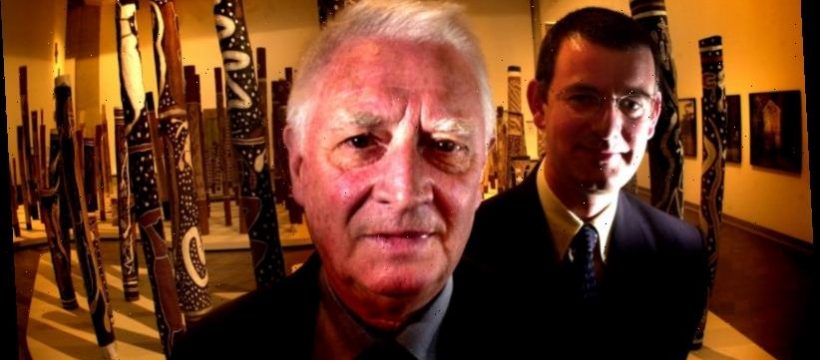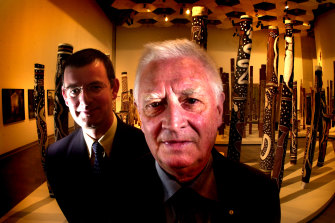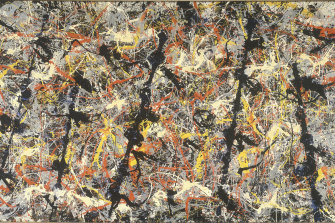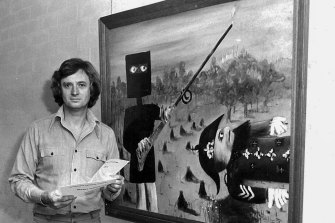James Mollison, the inaugural director of the National Gallery of Australia and a former director of the National Gallery of Victoria, was a man with an unfailingly sharp eye – and not just for art.
“He once said to me, ‘A good museum director is house proud’,” recalls art academic Chris McAuliffe of the ANU. “He said that as he pointed to the dust on the skirting boards in an art museum I was then running. But he meant much more than mere housekeeping, I think. He meant that a good museum director steers every element of the organisation, however incidental, towards the grand vision.”
James Mollison, foreground, in 2003, with then director of the NGA, Brian Kennedy.Credit:Andrew Campbell
But, McAuliffe adds, he did mean actual housekeeping too. “He told me that if I hadn't had the skirting boards cleaned by next week, he'd bring his own broom and do it for me.”
Mollison, who died at age 88 on the weekend, was described by NGV director Tony Ellwood on Monday as “an incredibly visionary leader. He took creative risks ahead of his time in the display and interpretation of art … introducing many new ideas, people and key acquisitions [to the NGV, under his directorship from 1989-95], including major contemporary works.
“He took his own path and his advocacy for modern and contemporary art was informed, brave and beyond what anyone else had done,” Mr Ellwood added. “He knew the importance of contemporary culture and didn’t shy away from it. He didn’t try to play the stereotype of the gallery director, he just got on with the job. He created a new paradigm which inspired the next generation of art museum professionals.”
Mollison had the rare privilege and responsibility of shaping a major art institution from the ground up. In 1971, John Gorton’s Coalition government appointed him acting director of the new gallery planned for the nation’s capital, long before it had a site, a building or even a finalised design. In 1977, he was officially made inaugural director, and in 1982 the building itself finally opened.
Detail from Jackson Pollock’s Blue Poles.Credit:
But it was Mollison’s decision to purchase Jackson Pollock’s abstract expressionist painting Blue Poles (also known as Number 11, 1952) in 1973, for a then-astronomical $1.3 million, that put Mollison and the art he championed firmly at the centre of the public conversation – if only because so many people decried it as a massive waste of money.
(With the painting valued in 2016 – for insurance purposes while on loan to the UK – at $350 million, that’s an argument Mollison, and the Whitlam government that backed him, clearly won.)
Though The Age’s art critic Robert Nelson is no fan of the NGA itself – “it sits as a monument to national pride in a kind of empty theoretical way rather than having an active influence on national consciousness,” he says – he does concede the value of its most iconic work.
“The NGA is a white elephant with one destination picture, Blue Poles, that was a shrewd purchase but perhaps a thing that nobody really loves,” he says.
Mollison with one of Sidney Nolan’s Ned Kelly paintings.Credit:Archive
NGA director Nick Mitzevich said his predecessor’s “fearless” choices inspired an entire country to talk about art.
“His impact was much wider than just art circles, wider than just galleries,” he said. “He had an impact on the debate about art and culture in Australia.”
Though his legacy was far greater than Blue Poles – he acquired significant works by Willem de Kooning, Constantin Brancusi, Arthur Boyd, Albert Tucker and Sidney Nolan, and championed Rosalie Gascoigne when she was still largely unknown – Pollock’s painting “was emblematic of his foresight and courage”, Mr Mitzevich said.
Commercial gallerist Anna Schwartz, who had known Mollison since the early 1970s, paid tribute to his “fastidious engagement” with contemporary artists and their practice.
“He didn’t require works to have the approval or approbation of others before he would deem them worthy,” she said. “He had an acute appreciation of art as it was being produced.
“Most museum collecting is collecting from history, not current practice, but the pieces from the 1960s and ’70s at the NGA were acquired at the time they were being made – and that’s very rare, not only in this country but anywhere. It meant that the NGA collection was really at the forefront of collecting in the world.”
That’s a view echoed by Max Delany, director of the Australian Centre for Contemporary Art.
He praised Mollison’s role in establishing the NGA as “visionary, profound and without parallel”, adding that it “totally changed Australian art and its relationship to the rest of the world”.
Follow the author on Facebook at karlquinnjournalist and on twitter @karlkwin
Source: Read Full Article



